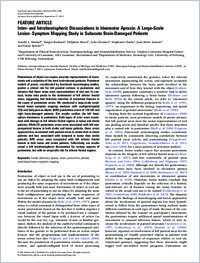Inter- and intrahemispheric dissociations in ideomotor apraxia : a large-Scale lesion–symptom mapping study in subacute brain-damaged patients
- Manuel, Aurelie L. Department of Clinical Neurosciences, Neuropsychology and Neurorehabilitation Service, Vaudois University Hospital Center and University of Lausanne, Switzerland
- Radman, Narges Department of Medicine, Neurology Unit, University of Fribourg, Switzerland
- Mesot, Delphine Department of Clinical Neurosciences, Neuropsychology and Neurorehabilitation Service, Vaudois University Hospital Center and University of Lausanne, Switzerland
- Chouiter, Leila Department of Medicine, Neurology Unit, University of Fribourg, Switzerland
- Clarke, Stephanie Department of Clinical Neurosciences, Neuropsychology and Neurorehabilitation Service, Vaudois University Hospital Center and University of Lausanne, Switzerland
- Annoni, Jean-Marie Department of Medicine, Neurology Unit, University of Fribourg, Switzerland
- Spierer, Lucas Department of Clinical Neurosciences, Neuropsychology and Neurorehabilitation Service, Vaudois University Hospital Center and University of Lausanne, Switzerland
-
2012
Published in:
- Cerebral Cortex. - 2012, vol. 23, no. 12, p. 2781-2789
English
Pantomimes of object use require accurate representations of movements and a selection of the most task-relevant gestures. Prominent models of praxis, corroborated by functional neuroimaging studies, predict a critical role for left parietal cortices in pantomime and advance that these areas store representations of tool use. In contrast, lesion data points to the involvement of left inferior frontal areas, suggesting that defective selection of movement features is the cause of pantomime errors. We conducted a large-scale voxel-based lesion–symptom mapping analyses with configural/spatial (CS) and body-part-as-object (BPO) pantomime errors of 150 left and right brain-damaged patients. Our results confirm the left hemisphere dominance in pantomime. Both types of error were associated with damage to left inferior frontal regions in tumor and stroke patients. While CS pantomime errors were associated with left temporoparietal lesions in both stroke and tumor patients, these errors appeared less associated with parietal areas in stroke than in tumor patients and less associated with temporal in tumor than stroke patients. BPO errors were associated with left inferior frontal lesions in both tumor and stroke patients. Collectively, our results reveal a left intrahemispheric dissociation for various aspects of pantomime, but with an unspecific role for inferior frontal regions.
- Faculty
- Faculté des sciences et de médecine
- Department
- Médecine 3ème année
- Language
-
- English
- Classification
- Biological sciences
- License
-
License undefined
- Identifiers
-
- RERO DOC 30514
- DOI 10.1093/cercor/bhs280
- Persistent URL
- https://folia.unifr.ch/unifr/documents/302568
Other files
Statistics
Document views: 129
File downloads:
- Document: 187
- Supplementary material: 130

